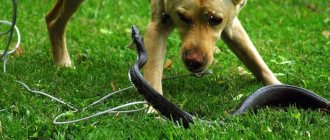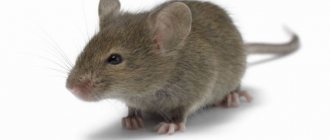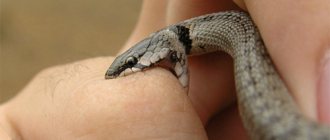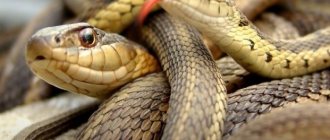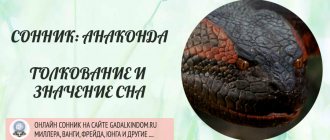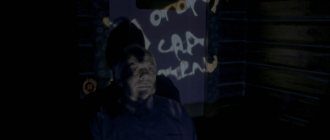Snakes fascinate with their beauty, mystery and incredible calm. The calmness of snakes is paired with their fury during an attack - this trait gives snakes their charm. Motley-colored snakes attract special attention because, in addition to beauty, they carry the destructive power of their poison.
To get to know these snakes better, look at photos of red snakes on the Internet.
King Cobra
The king cobra is not only beautiful, but also extremely dangerous. Its venom is the most deadly compared to the venom of all representatives of this species, and its length is about 3–4 meters.
Its color ranges from dark brown to yellow-green, and the hallmark of such a snake is its exquisite hood.
Photo source: https://pets2.me/
Garter snake / Thamnophis sirtalis
These small-sized snakes with different colors are also called garden snakes. They feel great both among the plains and high in the mountains.
They settled from Mexico to the northern regions of Canada. They lead a diurnal lifestyle and grow no more than 80 cm. Females are slightly larger than males. The only species of couchi gigas can reach a record height of 1.4 m.
They can be easily identified by the stripes along their entire body. In some species there are up to 8 such longitudinal stripes. They feed on tadpoles, frogs, and hunt salamanders and ground lizards. In total, more than 40 subspecies of garden snakes are distinguished in zoology.
7
Rainbow boa
This beautiful representative of the reptile family lives in Central and South America. Its scales are usually bright red, but in the sun they shimmer with all the colors of the rainbow.
Rainbow boas reach a length of about two meters, swim well and feed on small mammals like voles.
Photo source: https://zooclub.org.ua/
Distribution of red rattlesnake.
The red rattlesnake is distributed in Southern California, in San Bernardino, Los Angeles, Orange, Riverside, Imperial and San Diego counties. In Baja California, it is found on the border throughout the peninsula and on the islands of Angel de la Guarda, Danzante, Montserrat, San Jose, San Lorenzo de Sur, San Marcos, Cedros, Santa Margarita.
Red rattlesnake (Crotalus ruber)
Habitats of the red rattlesnake.
The red rattlesnake lives in the desert or in coastal scrub and chaparral thickets. Inhabits pine-oak forests, tropical deciduous forests and occasionally meadows and cultivated areas. It is most common in areas located at low altitudes. In the southern part of its range, the red rattlesnake prefers habitats with rocky outcrops. This species of snake avoids industrialized areas and is reluctant to cross highways.
Red rattlesnake (Crotalus ruber)
Belcher
Belchera is a sea snake. It lives in salt waters of Indonesia. In general, Belchers are friendly, but if angered, they are very aggressive and poisonous.
Belchera has a striped color, which allows it to hide unnoticed among the algae. And in crystal clear water it looks simply incredible.
Photo source: https://travelask.ru/
Sandy ephas / Echis carinatus
You can meet a small snake in the countries of Central Asia, Southeast Asia and the USA. It grows no more than 75 cm. In spring and autumn it is nocturnal, and in summer it is active during the day.
They have a light zigzag stripe on their sides, and the body itself is covered in dark, almost diamond-shaped spots. It moves along the sands using a kind of lateral movement. First he throws his head to the side, and then pulls his body up.
In India they are called rana, and in the USA - saw-scaled viper. It feeds on rodents and can hunt scolopendras and lizards. But, no matter what it is called, it is a very poisonous reptile.
By the way, on our website topcafe.su there is an interesting article about the most poisonous frogs in the world.
5
Rough tree viper
This snake looks like a shaggy reptile, but you should be careful with it. Beauty in the wild can often be deceiving. Despite the unusual appearance of scales and picturesque color, the snake is deadly poisonous to humans. So if you suddenly see her, it’s better not to introduce yourself tactilely.
Photo source: https://www.globaltalents.ru/
External signs of the red rattlesnake.
Experts recognize at least four subspecies of the red rattlesnake. In the northern part of their range, these snakes are brick-red, red-gray, pinkish-brown in color with a light brown belly. In southern Baja California they are often tan or olive-brown.
A reddish-brown pattern is present on the dorsal side of the body, and may be separated by a white or beige stripe on the front half of the body. The pattern is formed by 20-42 fragments, although usually there are 33-35. A number of small, dark patterns may be located on the side. The dorsal scales are keeled and without spines, excluding the lateral rows 1-2. The proximal segment of the rattle is black, and the tail has 2-7 black rings. Individuals living in continental areas have rattles of 13 segments.
However, some snakes on San Lorenzo de Sur lose segments during molting, and about half of the snakes in these areas do not have rattles. The red rattlesnake has a triangular-shaped head that is reddish with a dark diagonal stripe extending from the lower edge of the eye to the corner of the mouth. A stripe of light color runs in front. The pits that capture thermal radiation are located on both sides of the head, between the nostrils and the eyes. The maximum body length is 162.5 cm, although some snakes are 190.5 cm long. Males are larger than females.
The red rattlesnake (Crotalus ruber) is a deadly poisonous snake.
Reproduction of the red rattlesnake.
The mating season for red rattlers lasts from March to May, although in captivity mating can occur all year round. Males actively search for females, mating lasts several hours. The female bears offspring for 141 - 190 days and gives birth to 3 to 20 cubs. Young snakes appear from July to December, usually in August or September. They are similar to adults and are 28 – 35 cm long, but are colored a dull grayish color. The longest life expectancy of red rattlers has been recorded in captivity - 19 years and 2 months.
Horned viper
Despite the horns and aggressive appearance, this snake is very friendly. She will not attack a person first and will bite solely for the purpose of self-defense. Its scales rise up to look like sharp spines. The viper lives in the deserts of North Africa, and during the day it sleeps, burying itself in the sand. Therefore, when walking along the African sands, look carefully at your feet.
Photo source: https://www.zoopicture.ru/
South China Multistriped Krait / Bungarus multicinctus
The range of the beautiful snake extends to Taiwan, the southern regions of China, Vietnam, Myanmar, and Thailand.
The body is thin with a small head. The krait is poisonous, and grows no more than 1.5 m. Although in the wild there are individuals up to 1.85 m. The black body is covered with white transverse stripes. It feeds on rodents, eats insects, lizards.
Lives among rocks, sometimes rising to a height of 1,500 m above sea level. The contrasting black and white snake is easy to see, but it is better to avoid this dangerous reptile.
11
Jameson's Mamba (green mamba)
Unlike other reptiles, the mamba has a vibrant green color, which allows it to better hide in tropical foliage. Usually she sits in ambush for a long time, and then attacks quickly and fatally. Its poison is very extremely dangerous, so be careful during your trip through the jungle.
Photo source: https://zen.yandex.ru/
Coral adder / Micrurus
The multi-colored reptile has a distinctive pattern of red, black, yellow and orange rings. Color varieties depend on the species and habitat.
Distributed in North and Latin America, from Uruguay to the southern regions of the United States. They have deadly poison. After a bite, if an antidote is not administered and treatment is not provided, the person can die within 24 hours.
Handsome adders feed on small rodents, insects, and lizards. They can hunt amphibious forest inhabitants. In nature, there are several non-poisonous species that have adapted their color to their poisonous counterparts.
White Texas Snake
This snake is called a rat snake because it resembles the color of a white rat. Its snowy color has an admixture of soft pink, similar to the circulatory system of this animal. And her head is flattened and resembles a mouse muzzle. However, the snake is not so harmless in appearance. The snake is non-venomous, but its bites are painful and can cause allergies. But despite this, breeders love him very much.
Photo source: https://fotovmire.ru/
Varieties
Science knows only a few species (8) of royal individuals, but there are a huge number of subspecies. They all differ in color, body length, and shape, which allows snake lovers to create a unique collection in their terrarium.
For information! The colors found on the skin of a king snake cannot be found in the color of other reptiles or animals. These are variegated, rich shades of red, white, blue, hot pink, orange, yellow, brown and other colors.
Not all royals have a red tint; it is characteristic only of the smallest representative of the genus. This is a colubrid, non-poisonous individual, distinguished by its small size, bright stripes on the back and unpretentiousness in care and maintenance.
The little red snake is a real work of art. Her skin has many different shades and colors. These are stripes, inclusions, pronounced rings, uniquely shaped spots and even individual patterns. In some areas you can see spotted patterns.
Blue Racer
The snake with this unusual name is in danger of extinction. This partly explains her aggressive behavior towards people, so you shouldn’t even get in close contact with her. The snake has a soft blue color with white stripes. She develops high speed, for which she was nicknamed the racer.
Photo source: https://billionnews.ru/
Anaconda / Eunectes murinus
Among the dangerous giant scaly inhabitants of the planet, one of the most beautiful is the anaconda. Europeans first saw this huge creature in 1553.
The main color of the anaconda is grayish-green with two rows of dark spots. There are rows of small yellow spots on the sides. The body is massive, which is why it has practically no enemies in wildlife. Few people would dare to fight such a giant.
It feeds on mammals, and when settling near a person’s home, it attacks domestic animals. There are many legends associated with it, on the basis of which works of fiction have been written and films have been made.
9
Striated kingsnake
Due to its similar color, this snake can be confused with the poisonous coral adder. The difference is that the striated snake is much larger than the adder. The reptile feeds on lizards and small reptiles. This type of snake is predominantly nocturnal, so it can only be seen after sunset. She is not aggressive, but it is better to be careful not to run into an unfriendly individual.
Photo source: https://animalreader.ru/
Colubridae
A large family that unites more than half, up to 70% of the planet’s snake species. In the family, most of the colubrid representatives are not poisonous, except for the group of false snakes. Species differ in habitat - terrestrial, aquatic, arboreal, burrowing. Reptile lovers often keep colubrid reptiles in terrariums.
Forest already
Inhabitant of wet biotopes. More often found in tropical forests, on sea coasts, along river banks, near lakes, and swamps. The color is predominantly red-brown. Size from 50 to 100 cm. The diet is based on fish, worms, amphibians, and their larvae.
In Russia it is found in Primorsky and Khabarovsk territories. The most famous is the Far Eastern Japanese snake. Leads a hidden lifestyle, hiding among stones, in rotten stumps, and hiding underground.
Common snake
It settles in places close to water, swims well, and submerges under water for up to 20 minutes. On the ground it moves up to 7 km/h. Can climb trees. Body length 1-2 meters. The scales are ribbed. The dominant color is black, brown, olive tones.
A pair of yellowish-orange spots are often clearly visible along the back edges of the head. The belly is lightish, with dark spots of different geometries. Snakes are active during the daytime; at night they hide in hollows, forest floors, and rodent burrows.
In Europe, Asia, and North Africa it is found everywhere, except in the polar regions. On the territory of Russia, it is the most common snake that can be found even in populated areas among heaps of garbage, where it often finds refuge.
copperhead
A snake with smooth scales. There are varieties of copperheads with common characteristics. The names of the snake species are related to the color of the ore. The ancestors believed that copperheads that bit people would die by sunset, when the earth was painted with shades of copper. Non-venomous snakes are often confused in appearance with dangerous vipers.
An important difference is the shape of the pupils. In copperheads they are round, in vipers they are vertical. The color is gray-brown, except for fragments of copper coloring on the head. Sometimes males have inserts that are almost red in color. There are stripes with dark brown markings running down the body. In European territory, the copperhead is widespread.
Amur snake
The habitat includes mainly northeast China, Korea, Primorsky and Khabarovsk territories of Russia. The average size of the snake is 180 cm. The characteristic color is expressed by a dark back and head, on which there are transverse gray-yellow stripes.
There are many dark spots on the yellow belly. It spreads along forest edges and bushes and does not avoid human settlements. Many people find snakes in their plots, attics, and in mountains of construction waste. They feed on birds, often destroying their nests by climbing trees. The diet includes small rodents, amphibians, and food waste.
Dinodon eastern
Endemic to Japan. Cautious twilight snake. Selects habitats with many shelters. Body length 70-100 cm. The head is black above, light below, marked by a cervical interception.
The main body color is brown with black spots. The snake is not poisonous. For the purpose of self-defense, it hisses, rises, and can bite. Sometimes, when in danger, it buries itself in the ground and pretends to be dead. In Russia it is found on the Kuril Islands.
Collared Eirenis
A small, gracefully shaped snake. The body length is barely 50 cm. The main gray-brown tone has a mesh pattern due to the fact that the center of each scale is highlighted.
The dark stripe on the neck gives the species its name. In addition to a peculiar collar, brown-black spots cover the head of Eirenis. Snakes are found in Dagestan, Turkey, Iraq, and Iran. They prefer open, dry habitats.
pine snake
The preference for habitats in pine forests gave the reptiles their name. Leads a terrestrial life, although it moves well in trees. The snake is medium in size, body length does not exceed 1.7 m. The appearance of the snake is not striking in its uniqueness; its camouflage color is gray-brown with transverse spots of different shapes. They prefer rocky, dry places in the foothills and slopes. They live in the USA and Canada. When in danger, they tap their tails like rattlesnakes.
cat snake
The second name is house snake, since the reptile often climbs into human buildings. A rare species of medium-sized snake, up to 70 cm long. Habitats: the Middle East, the Caucasus, Asia Minor. In Russia it can be found in Dagestan.
The body is characteristically compressed from the sides, which gives it a slender appearance. The shields on the head are located symmetrically. The pupils are vertical. The color is gray-yellow, occasionally there are individuals with a pink tint. The back is covered with brown-black spots. The belly is lighter, the spots on it are small, sometimes absent. The corners of the mouth and eyes are connected by a dark stripe.
Lizard snake
The aggressive reptile is quite large in size. Body length up to 1.8 meters. Found in France, Africa, and the Mediterranean. The lizard snake is known for its speed of movement and eating lizards of its own size. Behavior is very cautious. Victims are often swallowed alive, without suffocation. A human bite is very painful, although not fatal. He tries to avoid meeting people.
Multi-colored snake
The habits of non-venomous snakes are similar to the behavior of the viper, which betrays aggression in loud hissing and lunging at the enemy. Saliva is toxic and causes pain, swelling, and nausea. Loves open landscapes with plenty of cover. It rises to the heights of foothills and rocky slopes. A special feature of the snake is its ability to dig holes with its head in soft ground, throwing the earth back.
Paradise tree snake
An amazing creature that can fly. Body length up to 1.5 meters. The snake lives in the crowns of trees and is perfectly camouflaged. Special shields on the abdomen and tail help to stay on the branches. Species of flying snakes include five representatives of the genus, among which the paradise snake is the brightest in color.
The shimmer of rich yellow, orange, and green colors seem to dissolve the animals in the foliage of tropical vegetation. Pushing off from a branch, snakes glide from a great height. In the air they become flat - they suck in their belly and make wave-like pirouettes to improve aerodynamics. Such flights help them cover a space of 100 meters. Snakes are not poisonous and are safe for humans.
Hieroglyphic python / Python sebae
Pythons are large snakes, and this handsome one can grow more than six meters. Moreover, its weight reaches 100–120 kg. They live just south of the Sahara in subtropical and tropical forests and savannah.
There is a characteristic dark spot and stripe on the head, and the whole body is covered with bizarre patterns reminiscent of mysterious writing. It is nocturnal, crawling out to hunt at sunset. They reproduce by laying eggs. One clutch can contain from 40 to 50 eggs. Very rarely 100.
Among its main enemies, besides humans, are Nile crocodiles and lions. Hyenas and mountain eagles also pose a danger to them.
